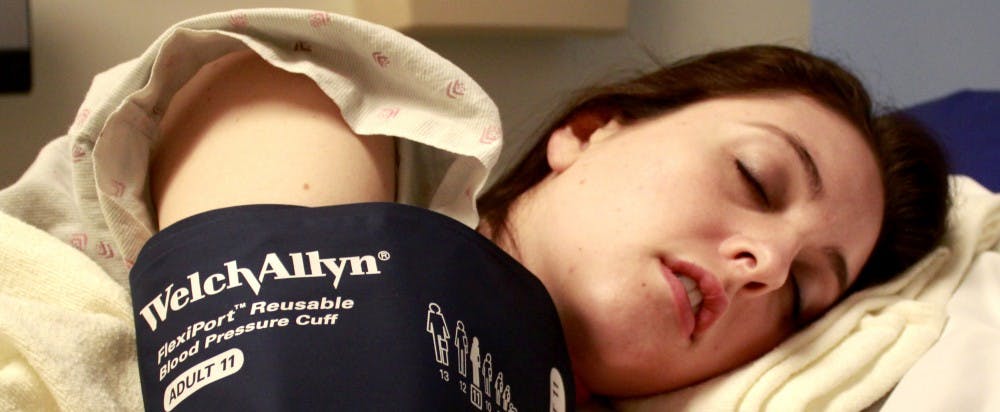[slideshow_deploy id='143603']
Crista Procopio, 22, is a recent graduate from the W. P. Carey School of Business with a bachelor’s in business public service and public policy. Not only did she acquire her degree, but also she is the former chair of the W. P. Carey Dean’s Advisory Council, a biotechnologist and the business development manager for a startup she launched through AZ Furnace. But Procopio is not your average college student: She suffers from Postural Orthostatic Tachycardia Syndrome – a neurological disorder that can leave some bedridden.
Procopio first noticed her POTS symptoms during elementary school, where she would feel inexplicably nauseous, dizzy and short of breath and experienced chest pain. She would be sent to the nurse’s office, where she would drink water and eat crackers, only to return to class shortly after with unresolved symptoms. These experiences continued through middle school and aggravated as she entered high school, with her first black out occurring at age 16.
 Procopio visits the Mayo Clinic Scottsdale campus for an appointment April 16. Diagnosed in 2011, Procopio underwent more than 35 different procedures prior to officially receiving a POTS diagnosis. POTS symptoms include extreme chest pain, dizziness, fatigue, migraines, nausea, shortness of breath, unusually high heart rate upon standing, gastrointestinal issues, difficulty regulating body temperature and fainting. Procopio also experiences brain fog, which impairs memory and makes it difficult to concentrate on tasks. (Photo by Danielle Grobmeier)
Procopio visits the Mayo Clinic Scottsdale campus for an appointment April 16. Diagnosed in 2011, Procopio underwent more than 35 different procedures prior to officially receiving a POTS diagnosis. POTS symptoms include extreme chest pain, dizziness, fatigue, migraines, nausea, shortness of breath, unusually high heart rate upon standing, gastrointestinal issues, difficulty regulating body temperature and fainting. Procopio also experiences brain fog, which impairs memory and makes it difficult to concentrate on tasks. (Photo by Danielle Grobmeier)Her POTS symptoms only worsened as she entered her freshman year at ASU in 2010. Eventually, the symptoms became so terrible that she experienced multiple fainting episodes in her dorm room and was forced to take a medical leave from the University during the 2011 spring semester. By that time, she was unable to get out of bed and had lost 20 pounds.
Because POTS shares symptoms with anxiety issues, Procopio was not diagnosed with the disorder right away. For months, she was incorrectly diagnosed with various anxiety problems as well as underwent test after test to rule out other potential disorders.
 Procopio visits the Banner Desert Medical Center emergency room April 21 for an emergency saline infusion during a POTS episode. She receives saline infusions on an as-needed basis as a “temporary quick fix,” and she has received about five so far this year. Usually a major fainting episode precedes a saline infusion. (Photo by Danielle Grobmeier)
Procopio visits the Banner Desert Medical Center emergency room April 21 for an emergency saline infusion during a POTS episode. She receives saline infusions on an as-needed basis as a “temporary quick fix,” and she has received about five so far this year. Usually a major fainting episode precedes a saline infusion. (Photo by Danielle Grobmeier)It was not until summer 2011 that Procopio was officially diagnosed with a disorder that affects the Autonomic Nervous System: POTS. The disorder causes irregularities in heart rate and blood pressure upon standing, gastrointestinal issues, dizziness, nausea, fatigue, shortness of breath and chest pain, potentially causing fainting episodes that can end in the emergency room. Procopio said because the Autonomic Nervous System regulates bodily functions from head to toe, she experiences symptoms from head to toe.
She returned to ASU for the fall 2011 semester and picked up where she left off in her college career as well as her work life, only this time, she knew she would be in and out of doctors’ offices, undergoing lifestyle changes to accommodate her illness, constantly medicating and battling her symptoms.
 Procopio loads gels in a lab at Midwestern University in Glendale. In addition to achieving her Bachelor’s degree at ASU, Procopio is biotechnology certified and has worked with Barrow Neurological Institute and Midwestern since 2009 leading an Alzheimer’s early diagnostic project. With a team, she launched her startup, Redox Diagnostics LLC, in 2013 and now acts as the business development manager. (Photo by Danielle Grobmeier)
Procopio loads gels in a lab at Midwestern University in Glendale. In addition to achieving her Bachelor’s degree at ASU, Procopio is biotechnology certified and has worked with Barrow Neurological Institute and Midwestern since 2009 leading an Alzheimer’s early diagnostic project. With a team, she launched her startup, Redox Diagnostics LLC, in 2013 and now acts as the business development manager. (Photo by Danielle Grobmeier)Procopio calls it an “invisible illness,” because from the outside, she appears normal and healthy, while on the inside she fights to keep her symptoms at bay and lead an active and successful life.




